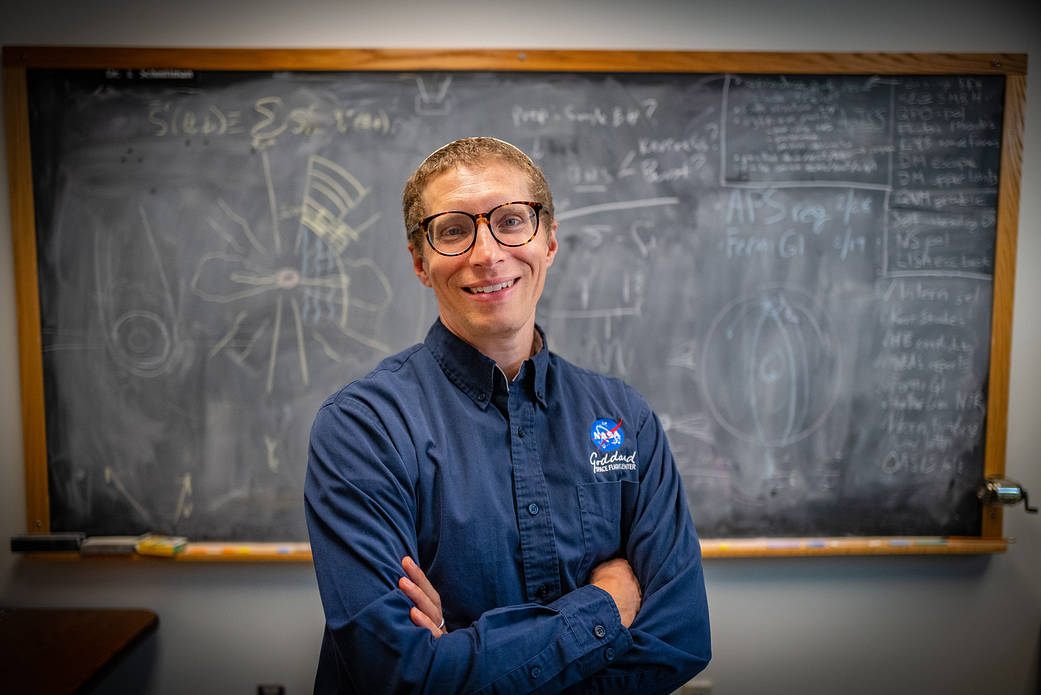Astrophysicist Jeremy Schnittman hopes to have one of his theories about black holes proven someday.

Name: Jeremy Schnittman
Formal Job Classification: Research astrophysicist
Organization: Gravitational Astrophysics Laboratory, Astrophysics Division (Code 663)
What do you do and what is most interesting about your role here at Goddard? How do you help support Goddard’s mission?
I try to understand the formation and properties of black holes. I also help develop ideas for new missions to study black holes.
What drew you to astrophysics?
I always liked science and math. The great thing about astrophysics is that it involves a little bit of everything – math, computer programming, physics, chemistry and even philosophy to understand the big picture, the enormity of space.
I have a B.A. in physics from Harvard, and a Ph.D. in physics from MIT. I came to Goddard in 2010 after two post-doctoral fellowships.
Credits: NASA’s Goddard Space Flight Center/Jeremy Schnittman and Brian P. Powell
Download high-resolution video and images from NASA’s Scientific Visualization Studio
As an astrophysicist, what do you think about?
I think of myself as a computational physicist as opposed to an experimental or observational physicist. I write many computer programs to do computer simulations of black holes. I also do a lot of theoretical physics, which is pencil and paper work. I think a lot about equations and math to understand black holes.
What is most philosophical about black holes to me is not so much what people most often think about, that their gravity is so strong that even light cannot escape. The really interesting thing to me is how time theoretically acts strangely around black holes. According to Albert Einstein’s theory of gravity, black holes change the flow of time. If you could get close enough to a black hole, theoretically you could go back and forth in time. All our experiments and observations seem to indicate that is how black holes might behave.
So much of how we experience the world is based on time, time marching steadily forward. Anything that changes that is a fascinating take on reality.
What do you tell the people you mentor?
I mentor undergraduate, graduate, and post graduate students in astrophysics. Since we are working remotely, I have students from all over the country. I help them with their research projects which mostly relate to black holes in some way. I also offer career advice and help them with their work-life balance. When possible, family comes first.
There are more people coming out of graduate school in astrophysics than there are jobs, so there are going to be many people who will not work for NASA or as a professor. Fortunately, there are a lot of other fascinating, related jobs, and I help guide the students there.
What do you do for fun?
I have a woodshop in our basement where I build furniture, dollhouses, toys, and other items for gifts. As a theoretical physicist, I don’t get to work in a lab. So it is nice to have some hands on experience.
I do a lot of hiking and cycling to exercise. I also enjoy spending time with my family.
Who is your favorite author?
Andy Weir is probably my favorite sci-fi author. I also love the epic naval historical fiction by Patrick O’Brian.
Who inspires you?
My childhood hero, who is still my scientific hero, is Albert Einstein. The more I work in astrophysics, the more he impresses me. Every single one of his predictions that we have been able to test has proven true. It may be a while, but someday I hope we prove his theories about time travel.
Also, I admire Kip Thorne, an American physicist from Cal Tech and recent Nobel laureate, who is “the man” when it comes to black holes. He is also a really nice, good guy, a real mensch. Very humble and down-to-earth. He is always extremely patient, kind and encouraging especially to the younger scientists. He is a good role model as I transition from junior to more senior status.
What is your one big dream?
I make a lot of predictions, so it would be exciting if one of my theories was proven correct. Hopefully someday.
By Elizabeth M. Jarrell
NASA’s Goddard Space Flight Center, Greenbelt, Md.
Conversations With Goddard is a collection of question and answer profiles highlighting the breadth and depth of NASA’s Goddard Space Flight Center’s talented and diverse workforce. The Conversations have been published twice a month on average since May 2011. Read past editions on Goddard’s “Our People” webpage.



























